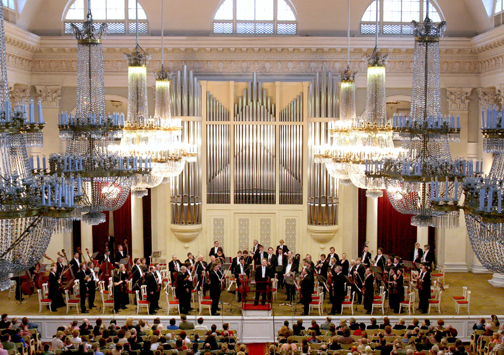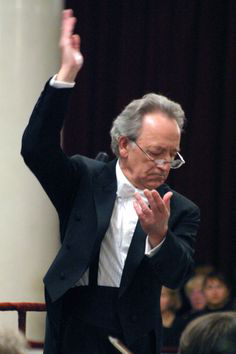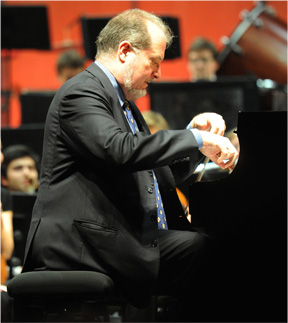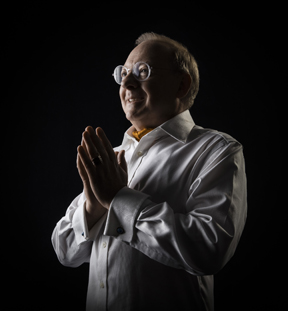By Robert D. Thomas
Music Critic
Southern California News Group
 Yuri Temirkanov and the St. Petersburg Philharmonic wrapped up a two-night Southern California tour last night at Cal State Northridge’s Valley Performing Arts Center.
Yuri Temirkanov and the St. Petersburg Philharmonic wrapped up a two-night Southern California tour last night at Cal State Northridge’s Valley Performing Arts Center.
Once upon a time, before the advent of jet aircraft and more open national borders, many orchestras maintained a national sound — i.e., their playing reflected sounds that emanated from their nations’ unique musical traditions. Today few of those distinctive orchestra continue, but perhaps the most significant still working is the St. Petersburg Philharmonic.
This ensemble is Russia’s oldest orchestra. Alexander III founded it in 1882 as the Imperial Music Choir, which then transformed into the Court Orchestra. Subsequently the orchestra’s name reflected the city’s name changes — e.g., State Philharmonic of Petrograd and Leningrad Philharmonic. In 1991, it became the St. Petersburg Philharmonic when the city resumed its historic name.
By whatever name, the St. Petersburg Philharmonic is recognized as one of the world’s great ensembles and last night performance showed why. A look at the orchestra’s roster shows it’s comprised almost entirely of Russian or Eastern European names, which is one big reason why it retains its distinctive national sound.
 Another reason is Yuri Temirkanov (pictured left), who made his debut with the ensemble 50 years ago and almost immediately became Assistant Conductor to the orchestra’s legendary leader, Evgeny Mravinsky. Now age 78, Temirkanov has been the ensemble’s Artistic Director and Chief Conductor since 1978, and he was on the podium last night at Cal State Northridge’s Valley Performing Arts Center.
Another reason is Yuri Temirkanov (pictured left), who made his debut with the ensemble 50 years ago and almost immediately became Assistant Conductor to the orchestra’s legendary leader, Evgeny Mravinsky. Now age 78, Temirkanov has been the ensemble’s Artistic Director and Chief Conductor since 1978, and he was on the podium last night at Cal State Northridge’s Valley Performing Arts Center.
For this second of two consecutive performances in Southern California Temirkanov constructed a quite different program than he conducted Wednesday night in Costa Mesa (my review is HERE). For VPAC he chose Brahms’ Piano Concerto No. 1 and Shostakovich’s Symphony No. 5.
What a difference a night made in terms of sound. At the Renée and Henry Segerstrom Concert Hall in Costa Mesa the orchestra was seated on risers, with the string basses grouped in a tight bunch on a top riser at the back left of the orchestra. Last night all the musicians’ chairs were on the floor and the basses were in a single line to the back left of the orchestra. That made for a more balanced sound with the violins more prominent throughout the night than had been the case the night before.
Moreover, unlike Segerstrom’s enveloping acoustic, VPAC has a dryer sound, which may have helped the balance but also diminished the sense of deep bass sonority except in certain key portions of the Shostakovich.
There was heightened pre-performance interest in Shostakovich’s fifth for a couple of reasons.
First, the Los Angeles Philharmonic, led by Jaap van Zweden, had just given an ultra-powerful performance of this best-known Shostakovich work last weekend in Walt Disney Concert Hall (REVIEW).
Second, Shostakovich’s music has been in the St. Petersburg Philharmonic’s DNA from the beginning. Mravinsky and the orchestra premiered five of Shostakovich’s symphonies (including the fifth in 1937) and the composer dedicated his eighth symphony to Mravinsky. Moreover, Temirkanov reportedly knew the composer.
The orchestra was absolutely at the top of its game in last night’s performance. The brass section was more prominent than in Segerstrom Hall and they sounded terrific, particularly in the Shostakovich. Everyone was locked in on Temirkanov, who — as always — conducted without a baton, using his hands and supple fingers instead to sculpture phrases and cue individuals with quiet gestures. He also invariably conducts with a score in front of him, a rarity in terms of conductors today.
The first movement was quite brisk and not as full of sturm und drang as one normally hears (although part of that may have been VPAC’s acoustics). The second movement featured razor-sharp precision from the strings’ pizzicato and the winds. In the third movement (in which the brass is silent throughout), the orchestra’s string sections unveiled that deep, sonorous Russian sound, with the cellos, in particular, digging deeply for their effects.
Much has been written about the symphony’s final movement — indeed, about the entire work. This was the piece with which Shostakovich regained favor with the Soviet government after a Pravda editorial (presumably authored by Joseph Stalin) had excoriated the composer for his opera Lady Macbeth of the Mtensk District. Whether that final movement did, indeed, represent a note of triumph or sarcasm toward the government has been debated and will continue to be debated forever.
Some conductors lead the final movement with increasing speed and force. It’s certainly a valid concept, one made famous by Leonard Bernstein, among others. On the other hand, Temirkanov’s tempos were more stately (even more so than van Zweden used in the L.A. Phil performance) and, rather than accelerating in the ending pages, Temirkanov held to his deliberate tempos to the very end, an equally defensible tactic that made for a spine-tingling conclusion.
Following the justifiably deserved standing ovation, Temirkanov and Co. responded with a luscious reading of the Amaroso from Prokofiev’s ballet Cinderella as an encore.
For whatever reason, several local orchestras have elected to begin their programs recently not with overtures and concertos but with major single works. To cite but two examples: the Pasadena Symphony recently began a program with Tchaikovsky’s Symphony No. 6 and last week the Los Angeles Philharmonic ‘s program opened with Beethoven’s Symphony No. 5. Wednesday night in Costa Mesa the folks from Russia opened with a 35-minute suite from Prokofiev’s ballet, Romeo and Juliet.
Neither Wednesday nor last night did Temirkanov pause to allow management to seat latecomers (Jaap van Zweden didn’t either after the first movement of the afore mentioned Beethoven’s 5th). Both conductors expected patrons to show up on time — what a concept!!! — although VPAC management did, regrettably, seat latecomers after the first movement
 Garrick Ohlsson (pictured left), who has appeared quite frequently in these parts, was the soloist for last night’s performance of Brahms first piano concerto. As always, Ohlsson sat quietly as he waited while Temirkanov and his band essayed the stormy opening section of the concerto. Ohlsson then delivered a riveting, regal reading, alternating pulsating power and majesty with the most delicate playing in the soft sections.
Garrick Ohlsson (pictured left), who has appeared quite frequently in these parts, was the soloist for last night’s performance of Brahms first piano concerto. As always, Ohlsson sat quietly as he waited while Temirkanov and his band essayed the stormy opening section of the concerto. Ohlsson then delivered a riveting, regal reading, alternating pulsating power and majesty with the most delicate playing in the soft sections.
I have always envisioned composers in heaven listening to people performing their music, and I like to think that Brahms would have turned to Mozart and said, “Now that’s exactly what I had in mind for this piece!”
As an encore, Ohlsson — who leaped onto the international scene when he won the 1970 Chopin International Piano Competition — offered a playful, yet elegant rendition of Chopin’s Mazurka in C-sharp minor, Op. 50, No. 3.
Hemidemisemiquaver:
• There were no notes about the music in VPAC’s printed program book.
• Details about VPAC’s 2017-2018 season will be released May 5.
________________________
(c) Copyright 2017, Robert D. Thomas. All rights reserved. Portions may be quoted with attribution.


